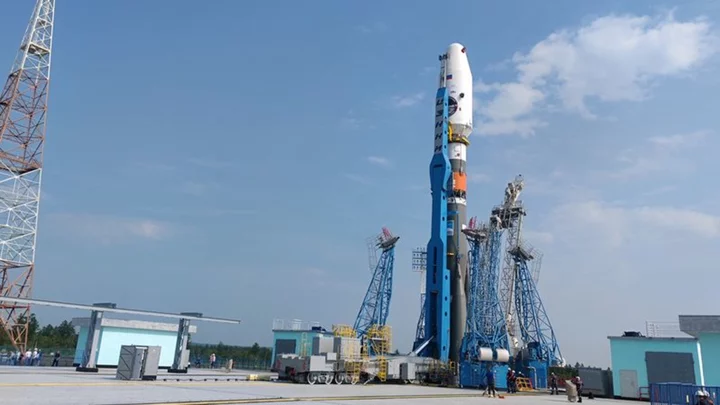
US space startups' latest struggles marked by layoffs, shake-ups
By Joey Roulette WASHINGTON U.S. space startups have slashed workforces and restructured operations to survive amid an investment
2023-08-16 00:21

Biden administration urges colleges to pursue diversity after Supreme Court ruling
By Nate Raymond and Jarrett Renshaw The Biden administration on Monday issued new guidance to colleges and universities
2023-08-15 03:29

Russian scientists start processing first data on Luna-25 craft - space agency
MOSCOW (Reuters) -Russian scientists have started processing the first data received on the Luna-25 spacecraft after switching on the scientific
2023-08-13 20:26

Russia launches lunar lander in race to find water on moon
By Guy Faulconbridge and Joey Roulette MOSCOW (Reuters) -Russia launched its first moon-landing spacecraft in 47 years on Thursday in
2023-08-11 07:51

Perseids 2023: Meteor beacon offers unique way to observe spectacular shower over UK
A group of amateur radio enthusiasts have set up a beacon in the UK that allows anyone to observe meteors as they burn through the Earth’s atmosphere. The UK Meteor Beacon project uses radio signals to identify meteorites as they pass through a 400 km-wide section of sky over England and Wales. The data is then displayed on a live online feed, with meteors appearing as blue streaks that emit a ping followed by a trailing pitch. The system captures more than 100 meteors every hour, even during times of relatively low activity. For the upcoming Perseid meteor shower, which peaks on 12 August, the frequency could be in the region of thousands per hour as Earth passes through the tail of the Swift-Tuttle comet. Unlike optical astronomy, the use of radio signals mean that meteors can be observed in nearly any weather conditions at all hours of the day and night. It also means that the system can pick up smaller meteors that may not appear as ‘shooting stars’ to the naked eye. This method of observation could potentially lead to the discovery of new meteor showers, which could then be tracked to uncover previously unknown comets. The radio transmitter is based at the Sherwood Observatory near Mansfield in Nottinghamshire, however receivers can be placed anywhere in the country. “The transmitter is illuminating the sky above Mansfield with radio signals that can be reflected by meteors and their trails,” Brian Coleman, who designed the system’s hardware and has a receiver in his back garden, told The Independent. “Even outside the Perseids and other meteor showers we’re seeing them at a rate of two a minute – and we can observe them day and night no matter what the weather. Only thunderstorms and lightning can interfere with it.” It is the first meteor beacon system run by amateur radio and astronomy volunteers in the UK, and has already received funding from the Radio Society of Great Britain and the British Astronomical Association. It has also gained the attention of academic and citizen scientists keen on studying meteors. Setting up the beacon transmitter is only the first part of the project, with the four-person team now planning to design and deploy echo receivers that can be distributed throughout the country at distances of up to 1,200 km from the Sherwood Observatory. The receivers can be built for as little as £10, according to Mr Coleman, using plastic pipes and other materials found in DIY stores. His hope is that the low cost will encourage schools to set up their own receivers to develop STEM-related projects that will encourage students to explore radio engineering and astronomy. Observations of the meteors from different directions can also be used to calculate the location and trajectory of meteors, with the team currently trying to establish whether it is possible to triangulate the meteors by studying the horizontal lines and blue smudges that appear on the waterfall display. Such measurements are currently possible with military-grade pulse radar systems, but it has never been done before on this scale. If it is possible, then knowing the speed and direction of the meteors will allow them to calculate the landing spot of any meteors that make it through the Earth’s ionosphere without burning up completely. These samples can then be studied to offer a better understanding of the universe. “The ultimate ambition is to have a system like Blitzortung, which uses a network of ground-based detectors to track live lightning strikes around the planet,” Mr Coleman said. “If successful, we could observe meteors entering Earth’s atmosphere in real-time throughout the world – but there’s still a lot of work to do before we achieve that.” Read More Amateur astronomers make ‘major breakthrough’ in saving Earth from asteroids ‘It’s becoming like an airport’: How SpaceX normalised rocket launches Perseid meteor shower offers best chance to see a ‘shooting star’ in 2023 Watch live: Russian cosmonauts step out of ISS to perform spacewalk Earth hit by powerful ‘X-1’ solar flare, after fears of ‘cannibal’ blast
2023-08-10 05:29

Earth hit by powerful ‘X-1’ solar flare, after fears of ‘cannibal’ blast
The Earth narrowly avoided being hit by a “cannibal” solar flare – but has been lashed by powerful enough blasts to disrupt communications. In recent days, space weather forecasters had warned that the Earth could be hit by a range of powerful flares that have been ejected from the Sun. Particular warnings focused on the “cannibal” flare, which was forecast to potentially glance Earth. “Cannibal” solar flares are formed when a later blast catches up with one that was ejected earlier, and consumes it. The energy of the two is combined, which can make them far more powerful than flares that are released on their own. The latest cannibal flare appears to have missed Earth, however. Forecasts had suggested that it was only expected to glance the planet, and so a miss was perhaps likely. The Earth was struck by an X-class flare, however. That is the most potent category of solar flares, and can cause considerable disruption on Earth. This time around, space weather experts warned that the blast was enough to disrupt radio and navigation signals in North America. It was measured as an R3 blackout – on a scale that runs from 1 to 5 – which meant that areas in the US and Canada as well as on the Pacific Ocean were at risk of having radio signals and navigation disrupted. The Sun moves through a cycle of activity every 11 years, during which it releases more and less “coronal mass ejections” or CMEs, and it is currently in a particularly busy part of that cycle. Those CMEs can bring energetic flares that hit Earth – and could one day cause considerable problems on the planet, disrupting energy grids and other important infrastructure. The latest flare was measured at X1.5 and is the 20th such X flare to have hit the Earth in its current period. It came out of a particularly active part of the Sun, and followed other, weaker flares, the UK’s Met Office said. Nonetheless, experts said the “minor ongoing solar radiation storm” was “waning” and that it did not expect significant disruption in the coming days. Read More Giant space ‘umbrella’ tethered to asteroid could protect Earth from climate crisis James Webb Space Telescope captures new images of the Ring Nebula Massive solar storm strikes Earth, Moon and Mars together for first time in history
2023-08-09 23:59

Russia to launch first moon lander since 1976 in race with Indian spacecraft
By Mark Trevelyan and Lidia Kelly (Reuters) -Russia will launch its first lunar landing spacecraft in 47 years on Friday
2023-08-07 21:15

After Supreme Court victory, anti-affirmative action group turns to military academy exemption
By Rachel Nostrant The group that took its case against affirmative action in college admissions to the U.S.
2023-08-04 03:26

Conservative activist behind US affirmative action cases sues venture capital fund
By Nate Raymond A group founded by the conservative activist instrumental in the U.S. Supreme Court's June decision
2023-08-03 02:51

Voyager 2: Nasa receives ‘heartbeat’ signal from missing spacecraft
Nasa has received a “heartbeat” signal from its Voyager 2 spacecraft – but it is still lost in space. Over the weekend, Nasa announced that it had lost contact with Voyager 2, which was launched in 1977 and is now hovering on the edge of the solar system. The space agency had inadvertently sent a message to the craft that instructed it to turn its antenna two-degrees from Earth. That in turn meant that it lost contact with the Deep Space Network, or DSN, a collection of ground-based antennas that allow for contact with distant spacecraft. Engineers feared that they would not hear from Voyager 2 until October at the earliest. Then, it will automatically adjust itself, resetting its orientation and pointing the spacecraft back towards the Earth, when the space agency hoped it would make contact. But Nasa has now heard a “carrier signal” from Voyager 2, sent back as the Deep Space Network scanned the sky. The space agency compared the signal to a “heartbeat”, in that it confirms that the probe is still safe and sending messages back down to Earth. Engineers will now try and send commands to Voyager 2, instructing it to re-orient itself and point back at Earth. If that happens then it will be able to continue on again as normal, flying out into interstellar space and providing scientists with information as it goes. The instructions might not get through, however. If that happens then engineers will be powerless to correct their mistake. That will mean they will be back to waiting until October, which will bring the point at which the spacecraft’s software will automatically tell it to reset its direction. Read More Giant space ‘umbrella’ tethered to asteroid could protect Earth from climate crisis Songs, books and films inspired by the blue moon ESA’s Euclid space telescope captures glittering galaxies and stars in first images
2023-08-02 02:20

How Many Dimensions Are There in the Universe?
According to string theory, there are at least 10 dimensions of space, most of which are impossible for humans to perceive.
2023-08-02 01:29

Can You Spot the UFO in This Space-Themed Brainteaser?
The truth is out there, but you may have to search every corner of the image before solving the puzzle.
2023-07-31 22:18
